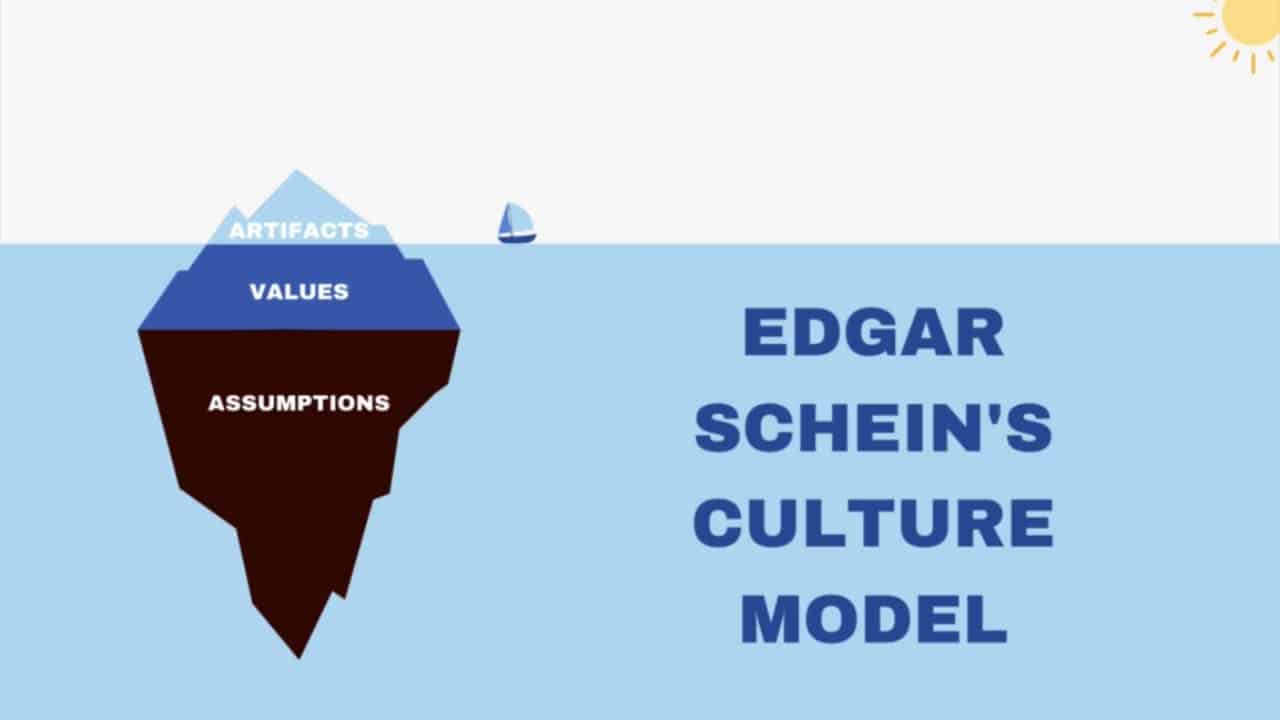Understanding the complexities of an organization’s culture is essential for effective management and leadership.
Developed by renowned MIT professor Edgar Schein, Schein’s Model of Organizational Culture provides a framework for deciphering the nuances of cultural artifacts, espoused values, and underlying assumptions within a workplace.
This model is a tool for academic analysis and offers practical insights for business leaders to assess, influence, and reshape their organizational culture.
The model breaks down culture into three distinct levels: observable artifacts, which include any tangible or verbally identifiable elements in an organization; espoused values, which reflect the explicitly stated values and norms; and, at the deepest level, underlying assumptions, which are the unconscious, taken-for-granted beliefs that truly drive the behaviors within an organization.
By dissecting these layers, leaders are better equipped to understand the motivations behind employee behavior and can more effectively direct cultural change.
Key Takeaways
- Schein’s Model provides a structured approach to understanding and shaping organizational culture.
- Leadership is pivotal in establishing and exemplifying an organization’s principles and beliefs.
- Cultural awareness and management are integral to enhancing organizational performance.
Edgar Schein’s Background
Edgar Schein, a leading authority in organizational psychology, has made a substantial impact with his comprehensive research on organizational culture and leadership. Here, we delve into his notable achievements and his connection to the MIT Sloan School of Management.
Contributions to Organizational Psychology
Edgar Schein is revered for his definitive impact on organizational psychology. He is best known for formulating the model of organizational culture, which became a foundational paradigm for understanding organizational dynamics.
His work laid down a comprehensive framework that categorizes organizational culture into three distinct levels: artifacts, espoused values, and basic underlying assumptions.
Beyond culture, Schein’s contributions span across various aspects of organizational studies, including career dynamics, group process consultation, and organizational learning.
His insights into the psychological underpinnings of corporate behavior have greatly influenced theories about organizational development and change management.
MIT Sloan School of Management
At the MIT Sloan School of Management, Schein’s long-standing tenure and his role as a professor emeritus underline his commitment to shaping minds in the field of management studies.
His legacy at MIT Sloan is profound. He was a thought leader and mentor to many students and professionals on the intricacies of organizational behavior.
Schein’s teachings and publications, originating from his association with Sloan, serve as vital resources for academics and practitioners alike.
Foundations of Schein’s Cultural Model
Edgar Schein’s contributions shape our understanding of how organizational culture forms, operates, and impacts businesses. His model articulates the pivotal elements that constitute workplace culture and offers a layered perspective on cultural components.
Defining Organizational Culture
Schein theorizes that organizational culture consists of a framework of fundamental beliefs collectively formed, uncovered, or refined by a group in response to the challenges of external adaptation and internal cohesion.
This established framework has proven sufficiently effective to be deemed legitimate, and it is consequently imparted to newcomers as the correct approach to understanding, reasoning, and experience.
The Three Levels of Culture
Schein’s Culture Model unfolds in three distinctive levels, each with a crucial role in shaping organizational behavior and values:
- Artifacts and Behaviors: These are visible organizational structures, processes, and behaviors. They are on the surface but can often be ambiguous and may not reflect the deeper levels of culture.
- Espoused Values: Beneath the artifacts are espoused values, which include strategies, goals, and philosophies. These are the articulated principles and standards that members claim to follow.
- Basic Underlying Assumptions: At the core are the basic underlying assumptions, which are unconscious, taken-for-granted beliefs and values. These assumptions are the essence of the culture and dictate behavior, powerfully influencing how group members perceive, think, and feel.
Schein’s model asserts that assumptions are the culture’s fundamental essence and deepest level, which is less tangible yet most influential. Artifacts and behaviors, albeit observable, lack clarity without understanding the underlying values and beliefs stemming from the group’s basic underlying assumptions.
Artifacts: Visible Organizational Attributes
Artifacts are the most observable and accessible layer of Schein’s Model of organizational culture. These physical, tangible expressions give immediate insight into a company’s character and are often the first elements observed by outsiders.
Symbols and Rituals
In every organization, symbols actively embody corporate values and are present in logos, branding elements, and specific office decor.
These symbols are a powerful form of non-verbal communication, often encapsulating the company’s mission and identity.
On the other hand, Rituals are repeated activities that foster unity and shared experiences among employees.
They range from annual company events to daily morning meetings reinforcing the organization’s values and behavioral norms.
Office Layout and Dress Code
The office layout is a spatial representation of a company’s hierarchy, work style, and values.
Open-plan offices promote transparency and collaboration, while cubicles may indicate a preference for individual workspaces and privacy.
The dress code reflects the organization’s culture and can vary from formal attire, reflecting traditional and perhaps more hierarchical structures, to casual wear, suggesting a more relaxed and modern environment.
Both the office layout and dress code are immediate, visible aspects indicative of the organization’s ethos.
Espoused Values: The Expressed Vision
Espoused Values are the expressed beliefs and standpoints that an organization formally states as its vision, goals, and philosophies. These values are critical as they guide the conduct and decision-making within the entity.
Stated Policies and Philosophy
Organizations articulate their Philosophies through official documents spelling out clear policies and guiding principles.
These policies serve as a framework for behavior and set expectations for actions that align with larger organizational goals.
They reflect the core Espoused Values an organization upholds—representing what they stand for and believe in.
Mission and Vision Statements
Mission Statements are succinct statements defining an organization’s mission, delineating its operational range with respect to its offerings, services, and target demographic.
In contrast, Vision Statements outline what the organization aspires to become in the future—a beacon that shapes strategic planning and action.
Both are foundational components in communicating an entity’s Goals and the desired path to achieve them.
Underlying Assumptions: The Core of Culture
Underlying assumptions form the essence of an organization’s culture. They are the unconscious, taken-for-granted beliefs that truly shape the workplace’s ethos.
Invisible Beliefs and Values
Underlying assumptions are the deepest level of Edgar Schein’s Culture Model, and they encompass an organization’s unspoken and often unconscious beliefs and values.
These invisible beliefs and values are the very foundation upon which the observable behaviors and artifacts rest. They are so deeply embedded that they are often accepted without question, influencing all aspects of organizational life.
- Assumptions: Psychological underpinnings that are rarely discussed or questioned.
- Beliefs and Shared Values: Fundamental convictions that guide behavior within the organization, often unarticulated.
Influencing Behaviors and Perceptions
The invisible nature of underlying assumptions means that they silently guide behaviors and shape the collective perceptions of an organization’s members.
These core values create a domino effect:
- They influence decision-making and relationships.
- They form the basis of shared values, which are more explicit yet still deeply rooted in the organization’s core.
- They are manifested in recognizable behaviors that reinforce the culture, further solidifying the underlying assumptions.
Leadership and Culture
The profound influence of leadership on a company’s culture is immeasurable. Leaders are instrumental in nurturing and maintaining the cultural ethos of a company, shaping actions that conform to the collective vision of the organization.
Role of Leaders in Shaping Culture
Leaders, specifically those in senior management, hold a cardinal responsibility: they are the instigators and custodians of an organization’s culture.
They model and communicate the core values and assumptions to the rest of the company, serving as a catalyst for cultural alignment.
Through consistent actions and decisions, leaders signal what is valued within the organization, thus shaping the underlying assumptions that Edgar Schein identifies as the essence of culture.
- Articulation of Vision: Senior management must vividly articulate a clear vision that provides direction and purpose.
- Consistency of Behavior: Actions and spoken words must align; leaders’ behaviors serve as a template for others in the organization.
Implementing Desired Behaviors
Culture must manifest in tangible, observable behaviors to be understood and embodied. Leadership is responsible for defining these desired behaviors and ensuring they are implemented throughout the organization.
- Alignment with Vision: Every policy, procedure, and system should reinforce the behaviors that align with the organization’s vision.
- Feedback Mechanisms: Constructive feedback helps maintain focus on the desired behaviors, and open communication channels ensure that managerial decisions support these endeavors.
Assessing and Analyzing Organizational Culture
Assessing and analyzing an organization’s culture is crucial for understanding its underlying dynamics and preparing for cultural change. It involves a deep dive into artifacts, shared values, and core assumptions as conceptualized by Edgar Schein.
Using Schein’s Model for Analysis
Assessment using Schein’s Model involves a comprehensive evaluation of the three distinct levels of organizational culture.
Artifacts are an organization’s tangible and observable elements, such as dress code, office layout, and company rituals. Although easily seen, their interpretation is often not as straightforward.
The second level, shared values, are the stated norms and rules that members of the organization are expected to follow. These values often shape the artifacts one sees.
For more profound insights, the model suggests examining the core assumptions, which are the deeply embedded, taken-for-granted behaviors that are often unconscious but constitute the essence of the organizational culture.
Using Schein’s model, analysis begins with observations and progresses through complex querying to uncover the less visible shared values and core assumptions.
This process sketches the current cultural landscape and establishes a reference point for potential cultural change efforts.
Tools for Cultural Assessment
Several tools can be leveraged alongside Schein’s Model to assess organizational culture accurately.
Surveys and questionnaires facilitate collecting information on artifacts and espoused values directly from employees.
Interviews and focus groups allow for a more nuanced exploration of shared values and core assumptions.
Observational methods can be particularly potent in revealing discrepancies between what is said and what is actually practiced within an organization.
Frameworks that complement Schein’s Culture Model, like the Competing Values Framework or the Organizational Culture Assessment Instrument (OCAI), offer structured approaches to culture assessment.
These tools can help triangulate findings and provide a multi-faceted view of an organization’s culture, augmenting the three-tiered analysis promoted by Schein’s Model.
Cultural Change and Management
Cultural change is an essential aspect of organizational settings, requiring adept management and strong leadership to ensure a positive impact on performance and competition.
Effective strategies and overcoming resistance are critical for the successful transformation of organizational culture.
Strategies for Cultural Transformation
- Assessment of Existing Culture: Before embarking on cultural transformation, an organization must thoroughly assess its existing culture.
This includes understanding deeply rooted assumptions and the prevalent norms that dictate employee behavior. - Leadership Involvement: Any cultural shift necessitates leadership that is visibly and genuinely committed to change.
Leaders should model the behaviors that embody the new values and performance expectations. - Communication & Engagement: Transparent and continuous communication is vital.
It helps align the team with the vision for change and facilitates their active participation. - Training & Development: Training equips employees with the necessary skills and knowledge to embrace new behaviors and practices.
Overcoming Resistance to Change
- Identify Reasons for Resistance: Resistance is a natural reaction to change. Identifying the reasons for resistance, whether they are fearful of the unknown or have lost their status, is the first step toward addressing them.
- Involve Employees in the Process: When staff members are engaged in the process of transformation, they tend to grasp the rationale behind the change and are more inclined to endorse it actively.
- Provide Support: Organizations should provide ample support mechanisms, such as counseling or mentorship programs, to help individuals navigate through change.
The Impact of Culture on Organizational Performance
The nature of an organization’s culture plays a pivotal role in shaping its performance and capacity for maintaining a competitive advantage.
Culture influences employee engagement and operational efficiency and drives the innovation necessary for sustained success.
Culture and Competitive Advantage
An organization’s culture encompasses its values, beliefs, and behaviors, collectively forming its unique identity and influencing how work is performed.
When culture is aligned with strategic objectives, it becomes a source of competitive advantage.
For instance, a culture that promotes accountability and continuous improvement can streamline decision-making processes and enhance an organization’s performance.
An environment that fosters risk-taking and adaptability empowers employees to innovate and respond to market changes swiftly, solidifying the company’s position in the industry.
Culture’s Influence on Productivity and Innovation
Productivity and innovation are essential ingredients in an organization’s growth and financial health.
A constructive organizational culture fostering teamwork and transparent dialogue can enhance efficiency as staff members unite in their efforts to achieve shared objectives.
On the innovation front, a culture that values creative thinking and problem-solving fosters a continuous flow of new ideas, which can translate into novel products, services, or processes that distinguish the company in the marketplace.
Comparisons with Other Culture Models
Schein’s organizational culture model offers a vibrant structure for grasping the subtleties of corporate existence. It highlights the stratified composition of culture and its effect on organizational conduct and efficacy.
This section will compare and contrast Schein’s model with the cultural models developed by Hofstede and Deal & Kennedy, as well as viewpoints from an anthropological perspective.
Hofstede and Deal & Kennedy
The cultural model developed by Geert Hofstede differs from Edgar Schein’s model in its method of categorization.
Hofstede categorizes national cultures using several dimensions, such as power distance, individualism versus collectivism, and uncertainty avoidance, while Schein’s framework focuses on the internal analysis of an organization through three core layers: artifacts, espoused values, and basic underlying assumptions.
Deal and Kennedy’s cultural model categorizes organizations based on the speed of feedback and the level of risk associated with the organization’s activities.
On the other hand, Schein’s model delves deeper into the psychology of organizational culture, examining the foundational beliefs that shape all aspects of organizational life.
Anthropological Perspectives
Anthropology, studying human societies and cultures and their development, provides a broader perspective on understanding culture.
Anthropologists study cultures from a holistic and comparative viewpoint. This approach encompasses a wide range of human behaviors and beliefs, providing a rich context for interpreting organizational culture.
Edgar Schein’s model shares similarities with anthropological methods by examining the deeply ingrained aspects of culture and their manifestations within the organizational context.
It connects the concept of culture in organizations to its more general understanding in the field of anthropology, considering the symbols, languages, and rituals that constitute organizational life.




